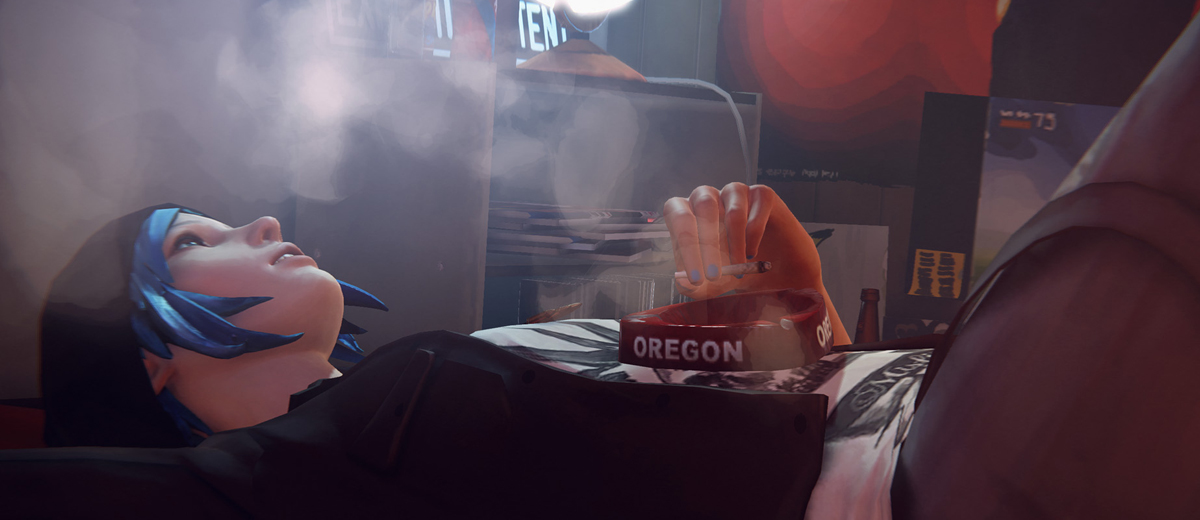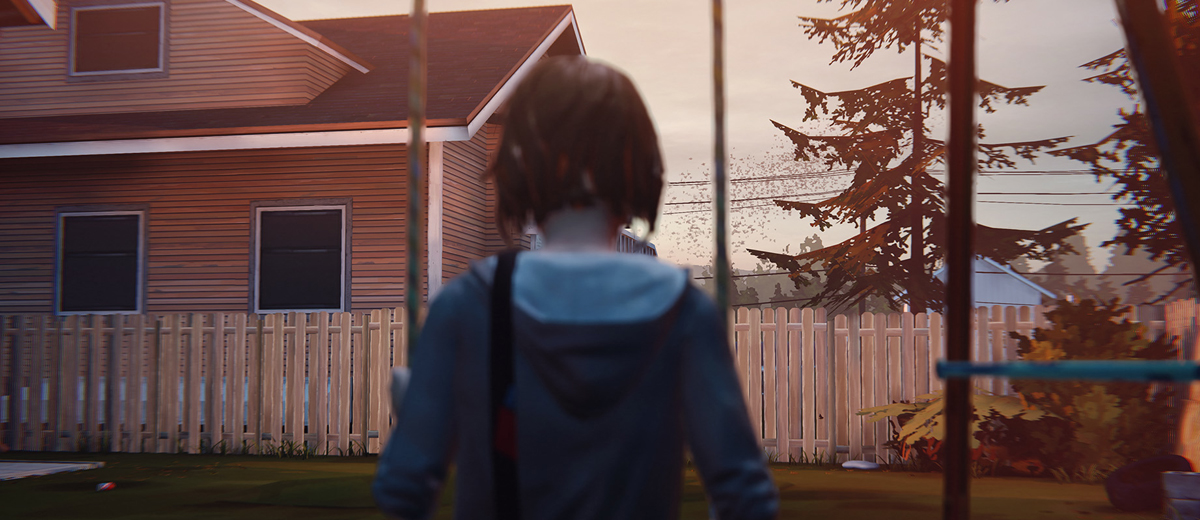
Life Is Strange is a five part episodic series that will be delivered over the next few months. This review is for Episode 1, titled Chrysalis. This review will attempt to cover the value of Episode 1 both by itself and as part of a larger experience. More importantly, given how important the story is to experience Life Is Strange, this review is spoiler free.
 Life Is Strange follows Maxine Caulfield, or Max for short. Returning to her hometown of Arcadia Bay in Oregon, she enrols in a prestigious academy as senior photography student, working with some of the most prestigious in the business. The academy is rife with rumours and speculations regarding the mysterious disappearance of Rachel Amber, a girl whose reputation changes depending on who you talk to.
Life Is Strange follows Maxine Caulfield, or Max for short. Returning to her hometown of Arcadia Bay in Oregon, she enrols in a prestigious academy as senior photography student, working with some of the most prestigious in the business. The academy is rife with rumours and speculations regarding the mysterious disappearance of Rachel Amber, a girl whose reputation changes depending on who you talk to.
Without spoiling, the events of Life Is Strange are thrown into motion when Max reunites with her estranged best friend Chloe, whose father died the year that Max left town. To make matters even more coincidental (or perhaps not), while Chloe was grieving for the loss of her father, she became involved with Rachel, the same girl who disappeared under mysterious circumstances. With a shared mutual interest and lots of time to make up for, Max and Chloe decide to investigate Rachel’s disappearance together.

The first episode is titled Chrysalis – and it couldn’t be a more apt title. For the most part, the story and characters are only lightly introduced and developed here but what’s worth mentioning is how well written it is. I don’t know about you, but a lot of the happenings that occur at Max’s school were pretty standard for my own experience throughout some of my schooling life. More importantly, however, for a game of this nature – most of the conflicts and mysteries are developed in a way that makes you want more after the first episode ends.
In terms of actual writing, the script is a little bit inconsistent. Some parts are genuinely funny and somewhat edgy but this sometimes errs too far over to the other end of the spectrum, being easily categorised as try-hard. But it’s hard to hate Life Is Strange for this – it just reminds me of when I was younger and I’m sure the older kids were cringing at all the things I was saying too. The characters themselves are similarly pretty well fleshed out and none of them really stick out as not belonging within the world of Life Is Strange. You’ll definitely develop your favourites (and least favourites) by the end of the first episode.
 Life Is Strange isn’t exactly pushing any of the systems it’s on but it makes up for these shortcomings with a very strong and distinct artistic direction. If I had to describe the visual style of the game – I’d say it’s The Virgin Suicides meets The OC meets Instagram. It’s a quirky and weird combination that oddly works together to give the game a dreamlike, almost idyllic feel that suits the indie tone and atmosphere that it’s going for. The game has a great sense of atmosphere that immediately draws you in to its world and events.
Life Is Strange isn’t exactly pushing any of the systems it’s on but it makes up for these shortcomings with a very strong and distinct artistic direction. If I had to describe the visual style of the game – I’d say it’s The Virgin Suicides meets The OC meets Instagram. It’s a quirky and weird combination that oddly works together to give the game a dreamlike, almost idyllic feel that suits the indie tone and atmosphere that it’s going for. The game has a great sense of atmosphere that immediately draws you in to its world and events.
On a technical level the game is pretty sound too – models look nice and stylised enough to hide any shortcomings of the engine. Every character looks great and animates well and realistically. But there’s still a few things wrong with Life Is Strange in terms of presentation. First of all, the game is running on Unreal Engine 3 which brings with it similar problems to other games running on that engine – namely some pretty noticeable and jarring pop-in of textures.

The voice work is also reasonable although as mentioned previously the script is a bit inconsistent. Still, all the actors and actresses give a realistic performance and there honestly weren’t any moments where the voice work would take me out of the game or the atmosphere. Rather bizarrely, however, it appears that there were no efforts whatsoever to provide accurate lip syncing which is very distracting during dialogue. Whether this is an issue exclusive to the Xbox One version, we don’t know, but it was easily the worst thing about the game on a presentation level.
In a rather surprising move the developers have opted to set the game against not only an indie soundscape but a licensed one. Most will probably recognise the tracks licensed from Jose Gonzales and Angus & Julia Stone that make brief (and very appropriate) appearances throughout the first episode while others may miss tracks from American indie rock band Sparklehorse as well as tracks from Syd Matters, a group hailing from DONTNOD’s native France. The music is used to great effect to give greater emotional weight to almost all of the scenes in Life Is Strange – nothing feels tacky or overdone.
 At its core, Life Is Strange is pretty typical adventure game. There’s little to no emphasis on action or combat and there’s not even a wide range of puzzles either. Instead, Life Is Strange opts to focus on a strong narrative experience as well as strong character interactions. You control Max directly, and can look or inspect at most things throughout the game world or interact with them if context permits.
At its core, Life Is Strange is pretty typical adventure game. There’s little to no emphasis on action or combat and there’s not even a wide range of puzzles either. Instead, Life Is Strange opts to focus on a strong narrative experience as well as strong character interactions. You control Max directly, and can look or inspect at most things throughout the game world or interact with them if context permits.
While it’s a largely linear affair, each area Max visits has quite a few things for her to do. She can speak to almost everyone she comes across to learn new things about both the missing girl and the person she’s talking to. She can play around with items to look for photo opportunities, or even snoop around certain areas in the game but with an assumed consequence.

The crux of Life Is Strange’s gameplay comes with the idea of the “Butterfly Effect”, the idea that the change of something small somewhere will somehow largely influence future and current events. Some of these changes are pretty obvious and blatantly presented to the player – for example whether you report suspicious behaviour to a member of staff.
Others are seemingly small but might have bigger changes later on in the story – actions as simple as watering the plant in your dorm or drawing words into a dusty van window will presumably have consequences in future episodes. The choices Max makes are permanent, and while the idea of these choices having ramifications throughout the rest of the story, it definitely feels like this idea and concept will be better realised in later episodes as the story begins to develop greater depth and tie itself up.

What really makes Life Is Strange unique is its Rewind mechanic – a power we’re sure everyone wishes they had in school. As an example, if Max (and by extension, the player) says something wrong you’re able to rewind time to try it all over again. The kicker? Max retains memory of everything she’s witnessed and items she obtains.
This separates it from other games that manipulate time and allows the developers to incorporate some interesting situations throughout the episode. The simpler choices are presented at the very beginning of the game – where Max can rewind after hearing the correct answer in class and repeat it afterwards to gain respect from her teacher. But there are more complex ones, especially one in the episode’s climax which we won’t spoil here.

What I particularly enjoy about Life Is Strange is how it doesn’t make any assumptions about player agency. If you wish, you can rewind as much as you want to experience all dialogue options before choosing to move the story forward. If you want to play it blind, you can do that too. But it’s the options on offer here that make things really interesting. One particular choice leads to a piece of knowledge that seems pretty important for Max to know – to the point where I couldn’t understand how the story could play out if said piece of knowledge wasn’t uncovered. Life Is Strange’s lack of apprehensiveness about players not experiencing everything it has to offer makes it feel more confident, in a way.
The point is that if you want to involve yourself in the story completely, the game lets you. There’s several journal entries dating back some time that help get you into Max’s character and her thoughts long before you even started playing as her. You feel like you’ve been put into the middle of a living, breathing world that’s existed long before you even started experiencing it. But if none of that is for you, the game is happy and confident to let you progress without doing so.

Replayability is almost always going to be an issue with episodic titles, especially when considering them both by themselves and as a whole. But Life Is Strange feels competitively priced considering how much content is on offer here. In Australia, each episode will cost $6.65 while the season pass will set you back roughly $20. If every episode is like the first episode, you can expect roughly between two and three hours for a standard play through, though the sheer amount of choices on offer (and multiple save slots) means that you’ll be sure to get more than that out of the game should you wish. Thankfully, given its writing and pacing, Life Is Strange feels appropriately priced without outstaying its welcome nor underwhelming the player.
But its overall experience easily rests on the magnitude of the consequences that will arise from the choices we’ve made in the game. Given the nature of these choices and their consequences thus far, great things can be expected from Life Is Strange.



